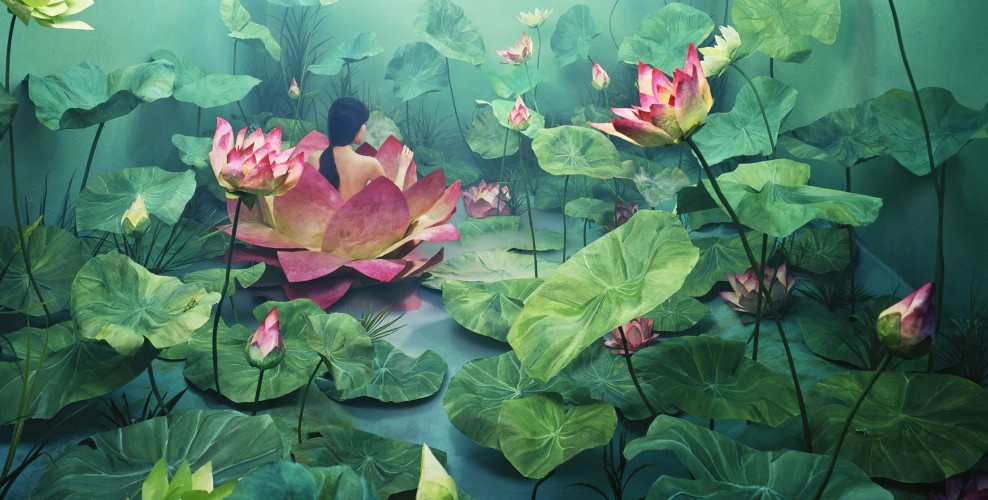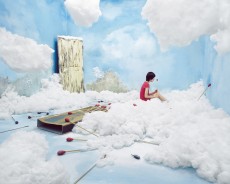 Jee Young Lee thinks inside the box. In fact, it’s a 360 x 600 x 240 cm set. However, when she turns the camera lens upon the meticulously handcrafted worlds within it, these become as infinitely expansive as the universe of the imagination – the true subject of Lee’s photography.
Jee Young Lee thinks inside the box. In fact, it’s a 360 x 600 x 240 cm set. However, when she turns the camera lens upon the meticulously handcrafted worlds within it, these become as infinitely expansive as the universe of the imagination – the true subject of Lee’s photography.
An earnest absence of any technological trickery (Lee employs no photo shop to achieve a somewhat trompe L’oeil effect) goes a long way in dazzling the viewer. However, the draw of her compelling tableaus – frozen fantasies featuring the artist as protagonist – are manifold.
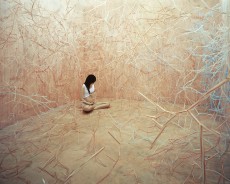 Dense and intriguing conceptualization, resonant symbolism, voyeuristic subjectivity and sheer beauty are just some of the elements that have placed so young a photographer so quickly on the map.
Dense and intriguing conceptualization, resonant symbolism, voyeuristic subjectivity and sheer beauty are just some of the elements that have placed so young a photographer so quickly on the map.
Their cumulative effect on the viewer is the singular experience of being transported to another realm, where one bears witness to an almost Jungian analysis of the artist’s subjective interiority – as palpable as the mundane reality within which this is manifested. Ultimately then, Lee’s works comprise a touchingly intimate, breathtakingly beautiful and often heartbreakingly vulnerable alternate-perspective of what, for some, may also constitute reality.
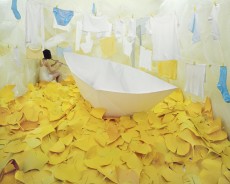 What are your most vivid memories of childhood?
What are your most vivid memories of childhood?
A lot of my childhood memories are of the countryside where I’d visit my uncle every weekend. There was a barley field right next to his house. I remember the barley being much taller than me. I would lose myself in the sea of green, although it was a naughty thing to do because it ruined the stalks. The green barley field swaying in the wind was a majestic scene. There were plenty of rice patties and fields around that house where I could catch insects and frogs. I ran around without a care, with my uncle’s dogs. At night I could hear the crickets. I would even come across some fireflies if I was lucky.
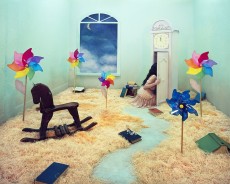 Like that actual world of green – and parallel to the physical spaces you currently create as an artist – did you create worlds for yourself in your mind as a child?
Like that actual world of green – and parallel to the physical spaces you currently create as an artist – did you create worlds for yourself in your mind as a child?
I was oftentimes lost in my imaginary world as a child. I carried this tendency into my adult years. I love spending time imagining things, but not every scene ends up in photography. My work derives from my imagination, from memories, from a mental landscape. But every element – from color selection to objects incorporated in the set – is highly symbolic within my own personal philosophy. I spend a lot of time trying out different combinations and pondering their correlations.
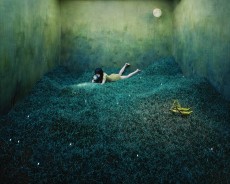 What was your favorite thing as a child, or a favorite way to play?
What was your favorite thing as a child, or a favorite way to play?
I have always been mesmerized with my mother’s wardrobe, and accessories. I loved to play adult. But my favorite activity was collecting unique rocks and observing captured insects. My favorites were snails, long-headed grasshoppers, and ants. I remember my father took me hiking quite often. I was excited every time I came across the shed skin of an insect or an empty beehive. I would walk around my apartment building grounds to capture dragonflies. I also liked to hide in the closet. Like many other young children, I had a firm belief that it was a gate to another dimension.
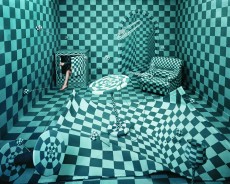 What were your favorite books/stories – Western and Eastern?
What were your favorite books/stories – Western and Eastern?
Western: Greek mythology, Andersen’s fairy tales, Grimm’s fairy tales, Aesop’s Fables, Maupassant, Franz Kafka, Jose Mauro de Vasconcelos’s My Sweet Orange Tree, Saint Exupery’s The Little Prince, Ernest Hemingway’s The Old Man and the Sea, Maurice Leblanc’s Arsène Lupin series, etc. Eastern: Korean folktales, Korean modern literature (many of which focus on hardships and despair), One Thousand and One Nights
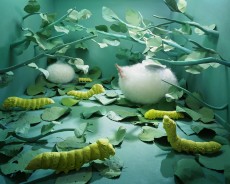 How did you discover art and what are some memories of the significance of art in your childhood?
How did you discover art and what are some memories of the significance of art in your childhood?
My mother never really made her debut as a painter, but she majored in fine art in college. I remember her oil paintings on the wall in our house. I dreamed of becoming an artist while gazing up at those paintings.
How did you begin to employ photography?
I had more interest in video when I was an undergraduate. But photography really sparked my interest when I chose it as the media for my degree exhibition. Those pictures in fact became the basis for the series I am working on today. The experience taught me that I can incorporate anything into photography; installation, sculpturing, painting, or performance art. 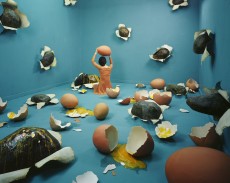 The distinctive feature of photography is that it records the truth and is proof of reality. My artistic world is a surreal visualization of my mental landscape. But photography portrays my take on reality – inspired by actual experiences and emotions – so it is ‘real’ in a way. Through photography, what I capture becomes a reality. Analyzing the self is one of the motivating factors for me in creating. People are always trying to capture a moment in time with photography. We always go back to these images to remember the moment. The mental landscape that I capture on camera is the same. It is a personal record that helps me document and reflect my life.
The distinctive feature of photography is that it records the truth and is proof of reality. My artistic world is a surreal visualization of my mental landscape. But photography portrays my take on reality – inspired by actual experiences and emotions – so it is ‘real’ in a way. Through photography, what I capture becomes a reality. Analyzing the self is one of the motivating factors for me in creating. People are always trying to capture a moment in time with photography. We always go back to these images to remember the moment. The mental landscape that I capture on camera is the same. It is a personal record that helps me document and reflect my life.
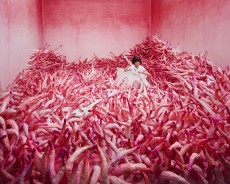 Hence, your current concept: one room, no photo shop – creating entirely new worlds? Discuss this process decision: to actualize in physical space an un-photo shopped fantasy realm?
Hence, your current concept: one room, no photo shop – creating entirely new worlds? Discuss this process decision: to actualize in physical space an un-photo shopped fantasy realm?
Yes. In order to realize the imaginary landscape in my head, I have to create a tangible space. This process is important because it invites the audience into my reality. I could have selected painting or some other medium /format but I chose photography because it captures the concept of my concept. I think my interest in production art and theatre also influenced this choice. Besides I have always enjoyed making things. These elements definitely influenced my creative process. The fact that everything happens in one room is also an important factor of my work. A room represents a private and personal space that reflects on the dweller’s characteristics and personality. And yes, I wanted recreate my mental landscape in reality. The scenes may not exist in the real world, but I want to invite 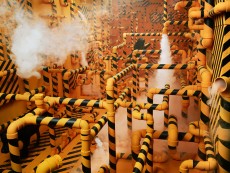 my audience into my reality, into the world as I see it. That is why it is important that I use installation. It brings an imaginary scene into the ‘tangible’ world. My creative process is to materialize objects and sceneries that only exist in my head. That is why I chose not to use Photoshop. It also stems from the thought that destroying the set once the final print is chosen is an extension of my creative process. I I take photos to objectify myself taking photos. I conceptualize the creating-photographing-destroying process as a process of self-analysis. The story is centered on my own experience, so I project myself into the character inside the photograph. Through this, I continuously remind myself of the incident that inspired the piece, overcoming the emotional distress as a result.
my audience into my reality, into the world as I see it. That is why it is important that I use installation. It brings an imaginary scene into the ‘tangible’ world. My creative process is to materialize objects and sceneries that only exist in my head. That is why I chose not to use Photoshop. It also stems from the thought that destroying the set once the final print is chosen is an extension of my creative process. I I take photos to objectify myself taking photos. I conceptualize the creating-photographing-destroying process as a process of self-analysis. The story is centered on my own experience, so I project myself into the character inside the photograph. Through this, I continuously remind myself of the incident that inspired the piece, overcoming the emotional distress as a result.
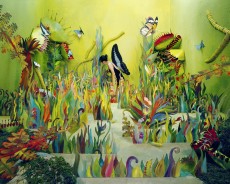 And, this is why you are always the subject?
And, this is why you are always the subject?
My photographs project my perception of reality. For that reason they are similar to portraits. The characters in my work represent my ego, so it makes sense that I am also the model. However, you will notice that some of the characters in the photographs are not me, they are close friends of mine. I use them as models too – if they go well with the atmosphere of the set. And yet, they still represent my ego.
You reference Korean folklore as well as Western literature (Shakespeare). What are some other influences?
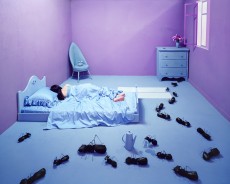 Every aspect of my environment has influenced me. My life is forever linked with the society of which I am a part. That includes my personal life, sentiments and emotion, childhood memories, experiences, and my career as an artist. It would be misleading to say that visual media and literature do not influence me, but I do not look for inspiration from outside sources. First, I try to look for inspiration from inside. The reason why Korean folklore and literature appear in my work is because it has left remnants in my memory. For this reason it is quite difficult for me to pinpoint what my major influences are.
Every aspect of my environment has influenced me. My life is forever linked with the society of which I am a part. That includes my personal life, sentiments and emotion, childhood memories, experiences, and my career as an artist. It would be misleading to say that visual media and literature do not influence me, but I do not look for inspiration from outside sources. First, I try to look for inspiration from inside. The reason why Korean folklore and literature appear in my work is because it has left remnants in my memory. For this reason it is quite difficult for me to pinpoint what my major influences are.
What about film, you mentioned you were first drawn to video?
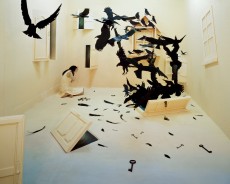 Black Birds was in part inspired by Alfred Hitchcock’s masterpiece The Birds. I can’t say that there has been another piece that was influenced by film. There is no saying there will not be though. If I watch a movie that leaves a lasting impression, it can show up on my photograph. Come to think of it, I did think of The Melancholy Death of Oyster Boy & Other Stories by Tim Burton when I was working on Toxic Boy. I have always been a fan of his movies. I remember being constantly worried about my reality and future and feeling desperate when I worked on this piece.
Black Birds was in part inspired by Alfred Hitchcock’s masterpiece The Birds. I can’t say that there has been another piece that was influenced by film. There is no saying there will not be though. If I watch a movie that leaves a lasting impression, it can show up on my photograph. Come to think of it, I did think of The Melancholy Death of Oyster Boy & Other Stories by Tim Burton when I was working on Toxic Boy. I have always been a fan of his movies. I remember being constantly worried about my reality and future and feeling desperate when I worked on this piece.
Whose photography do you currently admire?
Sophie Calle. I love the way she unravels her stories.
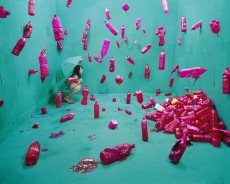 Describe your process: how long do the sets take? Is it a terribly expensive medium? Do you execute every aspect yourself?
Describe your process: how long do the sets take? Is it a terribly expensive medium? Do you execute every aspect yourself?
It takes over a month to complete one setup. The average time I use per photograph would amount to two months. When I have a subject or an idea, I draw a rough draft and search for materials and images to specify the details of the complete set. This is the most important step in my creative process; when the color scheme, object placement, angle, and posture of the model are decided. There is a wooden set in my studio that is 360x600x240 centimeters in dimension. The walls can be adjusted to make the set smaller or larger depending on the project. Once the set is fixed, I setup a camera angle and start building the elements from scratch. 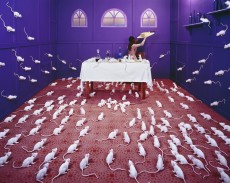 Sometimes the outcome is slightly different from the initial draft. When the set is complete, I take multiple test shots of the set, which are then carefully examined. I appear in many of my photographs, turning it into a self-portrait of sorts. The final output is taken with a 4×5 large format film camera. The set is dissembled once the final photograph is produced. I do not hire an assistant. I work alone throughout the entire process unless I am horribly pressed for time. This is a rule of mine that I have kept up until this point. The price range of the materials I use really depends on what I am making. Sometimes I use expensive materials. Other times I use cheap ones. You can see that I used a whole lot of straws and paper cups in some of my pieces.
Sometimes the outcome is slightly different from the initial draft. When the set is complete, I take multiple test shots of the set, which are then carefully examined. I appear in many of my photographs, turning it into a self-portrait of sorts. The final output is taken with a 4×5 large format film camera. The set is dissembled once the final photograph is produced. I do not hire an assistant. I work alone throughout the entire process unless I am horribly pressed for time. This is a rule of mine that I have kept up until this point. The price range of the materials I use really depends on what I am making. Sometimes I use expensive materials. Other times I use cheap ones. You can see that I used a whole lot of straws and paper cups in some of my pieces.
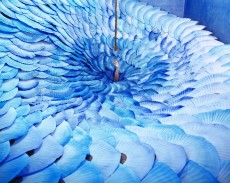 What are you working on next?
What are you working on next?
I would like to do more work about life itself. I’ve always had a keen interest in the universality as well as the distinctness of human life. My plan is to connect the varied impressions of life; my personal, emotional experience into complex formats – whether through video performance, photography, or installations. I would like to broaden my horizon too, by exploring life in general. Also, I am currently debating on what to subtract from my usual criteria to make the message more poignant.
-Larissa Zaharuk
To View more of Jee Young Lee’s work : http://www.opiomgallery.com/en/artistes/oeuvresphotographe/17/jeeyoung-lee

